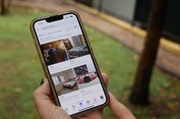Hackers breach 184 million accounts—act now to protect yours
By
Gian T
- Replies 9
If you’ve ever thought, ‘It’ll never happen to me,’ when it comes to online security, now’s the time to think again.
In what experts are calling a ‘cybercriminal’s dream,’ a massive data breach has just exposed the login details of over 184 million major online accounts—including some belonging to government officials across 29 countries, Australia included.
If you use any of these platforms, it’s time to take action—immediately.
The breach was discovered by cybersecurity researcher Jeremiah Fowler, who stumbled upon a staggering 47 gigabytes of sensitive data sitting on an unsecured server.
This wasn’t just any old list of emails—this database included usernames and passwords for accounts on Apple, Google, Facebook, Instagram, Microsoft, Netflix, PayPal, Roblox, Discord, and more.
Even more alarming, at least 220 of the email addresses had .gov domains, indicating that government employees from Australia, the US, the UK, Canada, and other countries were also affected by the leak.
Fowler described the find as ‘one of the weirdest’ in his career, and with good reason.
The database was managed by World Host Group, a global web hosting provider, but the company claims a fraudulent user uploaded the illegal content.
The origin of the data remains a mystery. Still, the most likely culprit is a type of malware called an ‘info stealer’—a sneaky program that quietly collects your login details and sends them off to cybercriminals.
Let’s be clear—this is serious. Suppose hackers gain access to your login details. In that case, they can log into your accounts to steal personal data or money, commit fraud or unauthorised transactions, engage in identity theft, deceive your friends and family through phishing scams, or even access sensitive government or business information.
For government employees, the risks are even higher—hackers could potentially access confidential or even top-secret systems, putting national security at risk.
Don’t panic, but don’t delay, either. Here’s what you need to do to protect yourself:
Unlike some recent breaches that involved ‘scraping’ public information from websites, this database included actual passwords in plain text—a sign that malware was likely involved.
The server was quickly taken offline after Fowler reported the breach, but there’s no way to know how many cybercriminals accessed the data before it was shut down.
This breach comes hot on the heels of another major incident, where over a billion Facebook users had their data scraped and put up for sale on the dark web.
It’s a stark reminder that cybercrime is on the rise, and no one is immune.
Use a password manager to create and store strong, unique passwords for each of your accounts.
Avoid reusing passwords across different sites, as this increases your risk if one account is compromised.
Make a habit of updating your passwords regularly, especially for critical accounts like email and banking.
Be wary of emails or messages that request personal information—even if they seem to come from someone familiar.
Finally, keep your devices and software updated to guard against the latest security threats.
If you’re worried your details might be among the 184 million exposed, you can check your email address on sites like Have I Been Pwned.
If your email shows up in a breach, follow the steps above right away.
Stay safe out there, and remember: when it comes to online security, a little caution goes a long way!
 Have you ever been the victim of a data breach or online scam? What steps do you take to keep your accounts safe? Share your experiences and tips in the comments below—your advice could help a fellow member avoid becoming the next victim.
Have you ever been the victim of a data breach or online scam? What steps do you take to keep your accounts safe? Share your experiences and tips in the comments below—your advice could help a fellow member avoid becoming the next victim.
In what experts are calling a ‘cybercriminal’s dream,’ a massive data breach has just exposed the login details of over 184 million major online accounts—including some belonging to government officials across 29 countries, Australia included.
If you use any of these platforms, it’s time to take action—immediately.
The breach was discovered by cybersecurity researcher Jeremiah Fowler, who stumbled upon a staggering 47 gigabytes of sensitive data sitting on an unsecured server.
This wasn’t just any old list of emails—this database included usernames and passwords for accounts on Apple, Google, Facebook, Instagram, Microsoft, Netflix, PayPal, Roblox, Discord, and more.
Even more alarming, at least 220 of the email addresses had .gov domains, indicating that government employees from Australia, the US, the UK, Canada, and other countries were also affected by the leak.
Fowler described the find as ‘one of the weirdest’ in his career, and with good reason.
The database was managed by World Host Group, a global web hosting provider, but the company claims a fraudulent user uploaded the illegal content.
The origin of the data remains a mystery. Still, the most likely culprit is a type of malware called an ‘info stealer’—a sneaky program that quietly collects your login details and sends them off to cybercriminals.
Let’s be clear—this is serious. Suppose hackers gain access to your login details. In that case, they can log into your accounts to steal personal data or money, commit fraud or unauthorised transactions, engage in identity theft, deceive your friends and family through phishing scams, or even access sensitive government or business information.
For government employees, the risks are even higher—hackers could potentially access confidential or even top-secret systems, putting national security at risk.
Don’t panic, but don’t delay, either. Here’s what you need to do to protect yourself:
- Change Your Passwords Immediately: If you use any of the affected platforms (Apple, Google, Facebook, Microsoft, Netflix, PayPal, Roblox, Discord, Instagram, etc.), change your passwords now. Make sure each account has a unique, strong password—no more ‘password123’ or your pet’s name
- Enable Two-Factor Authentication (2FA): This adds an extra layer of security by requiring a code sent to your phone or email whenever you log in. It’s a simple step that can stop hackers in their tracks, even if they have your password.
- Monitor Your Accounts for Suspicious Activity: Keep an eye on your emails, banking apps, and social media for any changes or transactions you didn’t make. If you spot anything odd, contact your provider immediately.
- Consider Freezing Your Credit and Setting Up Fraud Alerts: For extra peace of mind, you can freeze your credit or set up fraud alerts with your bank. This makes it significantly more difficult for anyone to open new accounts in your name.
- Be Wary of Phishing Scams: Hackers may use your stolen details to send convincing emails or messages pretending to be you or someone you know. Always double-check before clicking on links or providing information.
Unlike some recent breaches that involved ‘scraping’ public information from websites, this database included actual passwords in plain text—a sign that malware was likely involved.
This breach comes hot on the heels of another major incident, where over a billion Facebook users had their data scraped and put up for sale on the dark web.
It’s a stark reminder that cybercrime is on the rise, and no one is immune.
Use a password manager to create and store strong, unique passwords for each of your accounts.
Avoid reusing passwords across different sites, as this increases your risk if one account is compromised.
Make a habit of updating your passwords regularly, especially for critical accounts like email and banking.
Finally, keep your devices and software updated to guard against the latest security threats.
If you’re worried your details might be among the 184 million exposed, you can check your email address on sites like Have I Been Pwned.
If your email shows up in a breach, follow the steps above right away.
Stay safe out there, and remember: when it comes to online security, a little caution goes a long way!
Key Takeaways
- A massive data breach has exposed login details for over 184 million Apple, Google, and other online accounts, including emails linked to government agencies worldwide, Australia among them.
- Experts say this breach is a major cyber security risk, with stolen usernames and passwords that could be used for identity theft, fraud, or even national security threats.
- The exposed data was discovered by a researcher in a public server run by World Host Group, with suspicions the dataset was compiled using malware called infostealer.
- Aussies are urged to immediately change their passwords for affected platforms, enable Two-Factor Authentication, monitor accounts for suspicious activity, and consider placing fraud alerts on their banking and credit accounts.







